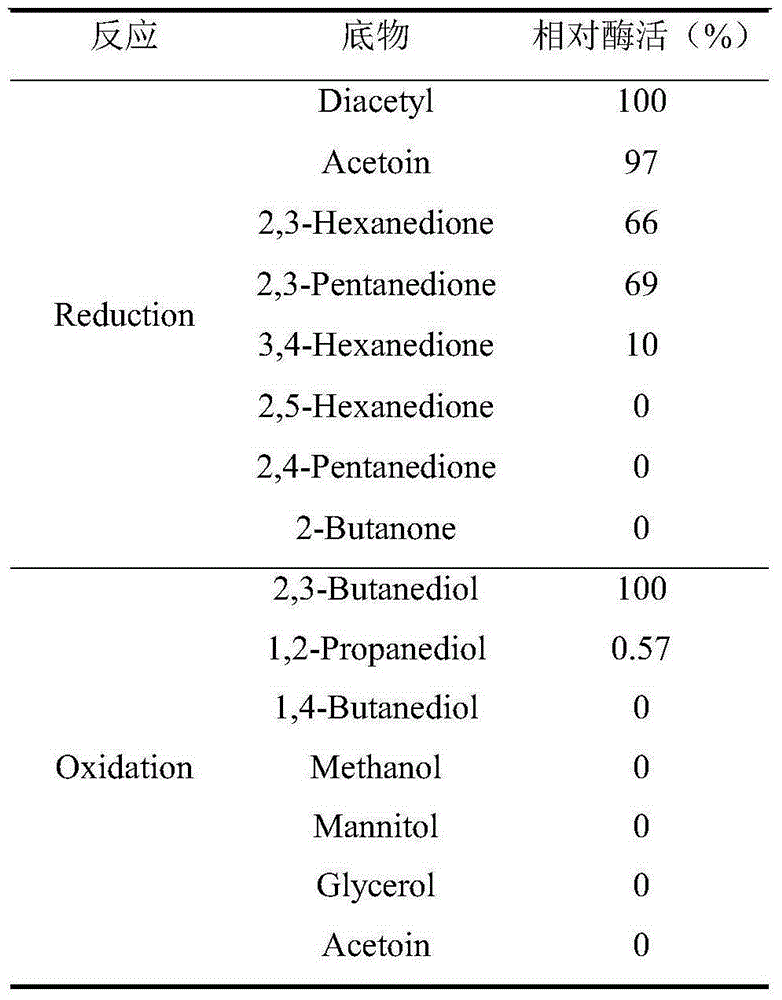Coding gene of meso-2,3-butanediol dehydrogenase, recombinase and preparation method and application of recombinase
A technology of meso-2 and butanediol dehydrogenase, which is applied in the field of bioengineering technology, can solve the problems of narrow asymmetric reduction substrate spectrum, low enzyme yield, and low overall catalytic activity, and achieve substrate applicability wide, high catalytic efficiency, and strong stereoselectivity
- Summary
- Abstract
- Description
- Claims
- Application Information
AI Technical Summary
Problems solved by technology
Method used
Image
Examples
Embodiment 1
[0022] Cloning of embodiment 1 meso-2,3-butanediol dehydrogenase gene
[0023] The meso-2,3-butanediol dehydrogenase gene in the above Bacillus licheniformis was cloned by shotgun method.
[0024] (1) First, the above-mentioned Bacillus licheniformis was cultured overnight at 37° C. using LB medium. After the bacterial cells were obtained by centrifugation, the total genomic DNA was obtained using a conventional bacterial genome extraction kit.
[0025] (2) Digest the total DNA with restriction endonuclease Sau3AI to form GATC cohesive ends. By controlling the enzyme dosage and reaction time, the total DNase is cut into 2-6kb fragments and recovered. These fragments were ligated with the pET28a plasmid digested with BamHI (recognition sequence GGATCC, cohesive end GATC), and the ligated products were transformed into competent cells E.coliBL21 ((DE3) After culturing at 37°C for 12-16 hours on the LB solid plate, pick a single colony for the next step of activity screening. ...
Embodiment 2
[0032] Example 2 Construction and cultivation of recombinant Escherichia coli BL21(DE3) / pET28a-Blbdh
[0033] The gene Blbdh and plasmid pET28a recovered in Example 1 were double-digested with restriction endonucleases BamHI and EcoRI in a water bath at 37°C overnight, purified by agarose gel electrophoresis the next day, and the target fragment was recovered using an agarose recovery kit . At 4°C, use T4 DNA ligase to ligate the excised gene Blbdh with the plasmid pET28a overnight to obtain the recombinant expression vector pET28a-Blbdh. The constructed recombinant expression vector pET28a-Blbdh was thermally transferred into Escherichia coli BL21 (DE3) competent, coated with Kan-resistant LB solid plate, and colony PCR verification was carried out after overnight culture. The positive clone was the recombinant Escherichia coli BL21 ( DE3) / pET28a-Blbdh. Pick positive clones and culture them overnight in LB medium, then transfer them into fresh LB culture at 2% transfer amou...
Embodiment 3
[0034] Embodiment 3 meso-2, the separation and purification of 3-butanediol dehydrogenase
[0035] Suspension-cultured recombinant cells were placed in solution A (20mmol·L -1 Sodium phosphate, 500mmol·L -1 NaCl, 20mmol·L -1 imidazole, pH 7.4), the crude enzyme solution was obtained after sonication and centrifugation. The column used for purification is an affinity column HisTrapFFcrude (nickel column), which is accomplished by using the histidine tag on the recombinant protein for affinity binding. First, use solution A to equilibrate the nickel column, load the crude enzyme solution, continue to use solution A to elute the breakthrough peak, and after equilibrium, use solution B (20mmol L -1 Sodium phosphate, 500mmol·L -1 NaCl, 1000mmol·L -1 imidazole, pH 7.4) for gradient elution to elute the recombinant protein bound to the nickel column to obtain recombinant meso-2,3-butanediol dehydrogenase. Enzyme activity assay (diacetyl as substrate, NADH as coenzyme) and SDS-P...
PUM
 Login to View More
Login to View More Abstract
Description
Claims
Application Information
 Login to View More
Login to View More - R&D
- Intellectual Property
- Life Sciences
- Materials
- Tech Scout
- Unparalleled Data Quality
- Higher Quality Content
- 60% Fewer Hallucinations
Browse by: Latest US Patents, China's latest patents, Technical Efficacy Thesaurus, Application Domain, Technology Topic, Popular Technical Reports.
© 2025 PatSnap. All rights reserved.Legal|Privacy policy|Modern Slavery Act Transparency Statement|Sitemap|About US| Contact US: help@patsnap.com



